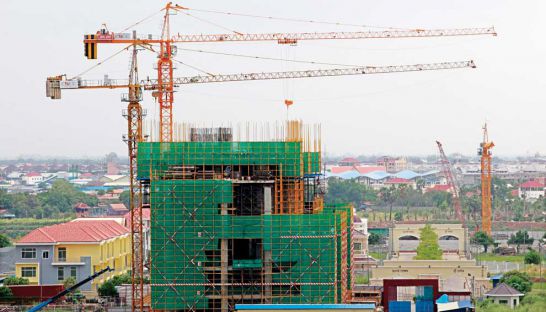Plans underway for clearer guidelines governing landmarks and heritage buildings
Plans underway for clearer guidelines governing landmarks and heritage buildings
As many tall buildings continue to pop up in Cambodia’s 500-year-old capital, ministries are continuing to place importance on preserving the cultural heritage of important historical sites and landmarks, ranging from ancient temples and monuments to pagodas and colonial buildings.
Seng Lot, spokesman for Ministry of Land Management, Urban Planning, and Construction (MLMUPC), told Post Property on Tuesday that up until now, the ministry has yet to draft a law for new construction developments around and near important landmarks, including monuments, or heritage sites.
“But the ministry has met with the City Hall authorities. We have agreed on some important sites such as Wat Phnom, the Royal Palace, and the Independence Monument,” Lot said.
“Around the Independence Monument, within 300 metres from the central point of the monument, all new buildings are not allowed to be built higher than 20 metres.”
“From 300 metres to 500 metres away, new buildings are allowed to be as only high as 30 metres.”
While Lot said these guidelines are nothing new, he said the ministry and City Hall continue to work closely together to ensure the suggested guidelines are being implemented.
He continued, “For the Royal Palace, measuring from the centre of the Palace, within a 300-metre distance, buildings are not allowed to be higher than 14 metres. Within 300 to 500 metres, buildings are only allowed to be 25 meters high.”
While there are no concrete laws in place governing new construction and proximity to historical buildings and landmarks, Lout said plans were underway for a more detailed framework.
“In the future, the city will draft a ‘height plan’ for all districts. There will be a clear distinction with help from the MLMUPC and the City Hall. We will work on one district at a time until we’re finished,” he said.
Prak Sovannara, general director of the heritage department at the Ministry of Culture and Fine Arts, said the ministry had successfully placed emphasis on the Kingdom’s heritage buildings, ancient temples, and historical landmarks.
He said, “The Ministry of Culture and Fine Arts has thought out sub-decrees related to heritage building management, referring to French colonial buildings; many of which are in Phnom Penh and other provinces like Battambang, Kratie, and Kampot.”
“We have drafted the sub-decree because we have to work with the authorities involved, such as the MLMUPC, the City Hall, and the grassroots authorities in the province,” Sovannara said. “As for the [heights] from the heritage landmarks, we have yet to draft it in details.”
At the same time, “we have organised a heritage mission team specialised in researching all forms of old heritage buildings in order to register and reserve them.”
“But the Ministry of Culture, which is known by the public as the protector of culture, abstract and representational arts, has a clear policy to ‘Conserve to develop, and develop to conserve’, because our country has to go forward,” he said. “Hence, conservation and development have to go hand-in-hand.”
Sovannara explained that Phnom Penh has many heritage sites such as Wat Phnom, the Royal Palace, various pagodas, and one small ancient temple that is now located in Ounalom Pagoda. Past and current developments have yet to severely impinge on the heritage sites.
Earlier this week, Post Property was unable to contact the two City Hall spokesmen for comment.














